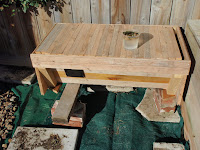Some of the advantages of a top bar hive (TBH) that I have seen in various publications are
- Simple to build, as opposed to the complex frames of the Langstroth
True, although the design is very well understood now and pre-made parts of readily available - Much less disturbance of the colony
This is the feature I am most interested in. The hive can be opened without creating a chimney that quickly cools the hive. It is also theoretically possible to inspect the brood nest without disturbing the storage and vice versa. I'm not sure yet, as I have only just populated my hive, whether this is practical as I can visualise the top bars being fairly well stuck together after a long period of with no inspections - Harvesting honey is simpler, though more destructive
I picture harvesting the honey with a bucket and a brush. Simply brush the bees off, then cut the comb off the top bar and drop it into the bucket. It should be possible to make an escape board to fit a top bar hive but I'll wait and see if its needed. - The combs and cells are the size the bees want, not the size of the manufactured foundation
- Very little off season storage required
No supers to store, closing a hive for winter should just involve sliding a separator into the hive, at the end of the brood area. - Less chance of transferring diseases like AFB
As no frames are removed and stored then redistributed there should be very little transfer of materials between hives. It is still possible to boost the population of one TBH with a comb of brood from another hive, but that is easily kept track of.
I bought some native timber tongue and groove from a demolition firm (for the body of the hive) and some untreated boxing timber for the top bars. The base is some fibreglass fly screen and the lid is just a frame made with some tongue and groove and black plastic. I intend to bend some galvanised iron on to it at some point but the plastic will do for now. I've also but some carpet underlay between the roof and top bars to provide some insulation.
 This is the finished product with a house warming gift for the new occupants. The black square on the side is a CD case that is glued in place and can be opened to peer inside (more on this in a later post). On the right you can see the landing area and the hive with no top bars.
This is the finished product with a house warming gift for the new occupants. The black square on the side is a CD case that is glued in place and can be opened to peer inside (more on this in a later post). On the right you can see the landing area and the hive with no top bars.  I'm not sure that putting the entry perpendicular to the combs is a good idea but I'm sure I'll find out soon enough.
I'm not sure that putting the entry perpendicular to the combs is a good idea but I'm sure I'll find out soon enough. You can see the fly screen secured to the bottom of the hive in this upside down photo. The intention is to cut a board that will cover the fly screen material in winter to reduce drafts.
You can see the fly screen secured to the bottom of the hive in this upside down photo. The intention is to cut a board that will cover the fly screen material in winter to reduce drafts. The top bars are untreated boxing timber ripped down to the correct width (see the plans at biobees) and then a groove is sawn to a depth of 2mm up the center. I've then melted some wax and pored a patch in the middle to encourage the bees to build their combs in the 'correct' place. The correct place being where I want them to build the combs.
In a later post I'll cover the trials I had getting the bees to stay, but I think I've solved that problem now. All that remains to be seen is whether they will survive the winter.

No comments:
Post a Comment